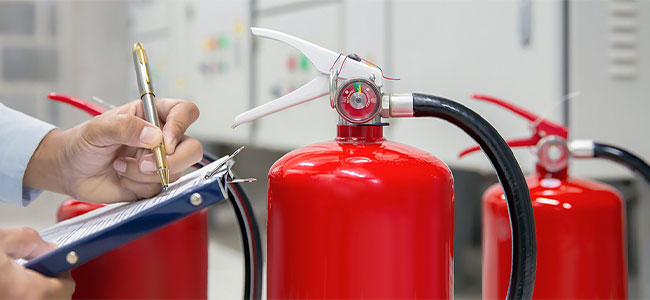
Fire Extinguisher Facts that Every Safety Professional Should Know
The most consistent violations during inspections relate to fire extinguisher annual service and inspection. Here's what safety professionals need to know.
- By Tunzyaan Griffin
- Nov 15, 2023
In buildings of varying occupancy, classifications such as Business, Assembly, Minor Mercantile, Educational, Healthcare, Industrial and other designations are all required to have portable fire extinguishers installed. As a safety professional, one verifies that the fire extinguisher installed is tagged, mounted, inspected monthly and identified in a clear and obvious manner. The safety professional looks at the third-party contractor’s annual inspection tag and makes sure it is current.
But how do you know that the annual inspection of a fire extinguisher has been properly completed other than just looking at a date on a tag? The most consistent violations during inspections relate to fire extinguisher annual service and inspection. To make sure there is a clear understanding, let’s look at what the code says about fire extinguishers, specifically in the National Fire Protection Association’s NFPA 10.
“Periodic inspection or electronic monitoring of fire extinguishers shall include a check of at least the following items: (1) Location in designated place (2) Visibility of the extinguisher or means of indicating the extinguisher location (3) Access to the extinguisher (4) Pressure gauge reading or indicator in the operable range or position (5) Fullness determined by weighing or hefting (6) Condition of tires, wheels, carriage, hose and nozzle for wheeled extinguishers (7) Indicator for non-rechargeable extinguishers using push-to-test pressure indicator,” NFPA 10 Section 7.2.2 Inspection Procedures states.
NFPA 10 Section 7.3.2 requires the annual external examination of all extinguishers. This includes examining the physical condition of the portable fire extinguisher. An annual external visual examination of all fire extinguishers shall be made to detect obvious physical damage, corrosion and nozzle blockage; verify that the operating instructions are present, legible and facing forward; that the Hazardous Materials Identification System (HMIS) information is present and legible; and to determine if a 6-year interval examination or hydrostatic test is due (NFPA 10 Section 7.3.2.1).
Meanwhile, NFPA 10 Section 7.3.2.1.1 states, “At the time of the annual external visual examination, a check of at least the inspection items of 7.2.2 and the external examination items of 7.3.2.1 shall be conducted.” NFPA 10 Section 7.3.2.2 relates to seals or tamper indicators. At the time of the maintenance of a rechargeable fire extinguisher, the tamper seal shall be removed by operating the pull pin or locking device. 7.3.2.2.1 dictates that “after the applicable maintenance procedures are completed, a new listed tamper seal shall be installed.”